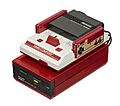Third generation of video game consoles facts for kids
The third generation of video game consoles, also known as the 8-bit era, began on July 15, 1983. This is when Nintendo released its Family Computer (called the Famicom) and Sega launched its SG-1000 in Japan. The Famicom was later updated and sold as the Nintendo Entertainment System (NES) outside of Japan. This period was important because it marked the end of the video game crash of 1983. It also showed a big change: Japan became the leading country for making home video game consoles, taking over from the United States.
During this generation, technology got much better. Consoles could now show improved graphics and sounds, similar to popular arcade games of that time. Games had more colors on screen, bigger pictures, and smoother movement. This allowed game creators to make more detailed and lively scenes. A cool new feature was game cartridges that could save your progress! Nintendo's The Legend of Zelda was one of the first games to use this. This meant games could have much bigger worlds and longer stories, as players didn't have to start over every time. Saving games became a standard feature in future consoles.
The NES/Famicom from Nintendo was the best-selling console of this generation. Next came the Master System from Sega (which replaced the SG-1000), and then the Atari 7800. Even though older consoles also used 8-bit processors, it was during this time that consoles started being advertised by their "bits." This happened especially when the next generation of 16-bit systems like the Sega Genesis came out, to show they were newer and more powerful. The Famicom/NES was most popular in Japan and North America. However, the Master System was very popular in Brazil, and sales were more balanced between the two in Europe. The third generation ended when 16-bit systems arrived and when the Famicom was finally stopped being made on September 25, 2003.
Contents
The Start of a New Era (1983–1984)
In 1983, the Japanese video game market was still growing. Only about 300,000 consoles had been sold in Japan by then, compared to millions in the United States. Many Japanese companies wanted to join this growing market. The Epoch Cassette Vision, released in 1981, was the most popular console in Japan at the time.
The third generation truly began when Sega and Nintendo, two Japanese companies, decided to enter the home console market. On July 15, 1983, they both released new consoles in Japan: Sega's SG-1000 and Nintendo's Famicom. Both companies were already successful in making arcade games. Nintendo wanted the Famicom to be powerful, like their Donkey Kong arcade game, but also cheaper than other consoles. The Famicom quickly became very popular in Japan, beating the Cassette Vision to become the best-selling console there. Sega's SG-1000, while not as successful as the Famicom, was an important step for Sega in the console world.
After its success in Japan, Nintendo wanted to bring the Famicom to the rest of the world. They talked to Atari, a big American company, about selling the Famicom in North America. However, problems with game rights and the video game crash of 1983 made Atari lose its market power. So, Nintendo decided to launch the console on its own.
Nintendo's Big Move (1984–1986)
After the video game crash, many people in the US were hesitant about home consoles. So, Nintendo first brought the Famicom to North America as an arcade machine called the Nintendo Vs. System in 1984. It was a huge hit in arcades, which gave Nintendo the confidence to release the Famicom as a home console in North America.
In January 1985, Nintendo showed off a version of the Famicom called the Nintendo Advanced Video System (NAVS) at a big electronics show. It had wireless controllers and a light gun. This system was later updated and shown again in June 1985 as the Nintendo Entertainment System. The NES was first released as a test in New York City in October 1985, bundled with the game Super Mario Bros.. This test showed that people still wanted to play games, even after the crash. Because it was successful, the NES was released across all of North America in February 1986 for $159.
In 1985, Sega released the Master System, which was an improved version of the SG-1000. It had better graphics and special effects than the NES. However, the NES continued to be the most popular in North America and Japan. The Master System found more success in Europe and South America.
The NES became incredibly popular in Japan and North America. This was partly because Nintendo had strict rules about which games could be made for their console. This period marked a big change, with Japan becoming the leader in home video games. By 1987, Nintendo had about 65% of the console market sales.
The Golden Age of 8-bit Gaming (1986–present)
The popularity of Japanese consoles grew very quickly. By 1988, the market for Nintendo game cartridges was bigger than for all home computer software! Nintendo sold seven million NES systems in 1988 alone. This huge success even helped computer game sales grow. However, by 1989, Nintendo's popularity caused problems for some computer game companies, as kids wanted consoles instead of computer games. By 1990, 30% of American homes owned an NES.
This era brought many important changes to video games. It saw the release of some of the first console role-playing video games (RPGs). Many famous game series that are still popular today started during this time. Some examples include Super Mario Bros., Final Fantasy, The Legend of Zelda, Dragon Quest, Metroid, Mega Man, Metal Gear, Castlevania, and Phantasy Star.
In Europe, the Master System was more popular than the NES in some areas until about 1990. But eventually, the NES caught up and even surpassed the Master System in Western Europe, though the Master System remained strong in countries like the United Kingdom and Brazil.
The third generation also saw the beginning of educational consoles for children. These systems were usually simpler and not advertised by their "bits" like the main gaming consoles.
The Atari 7800 and Master System were stopped being made in North America by 1992, while the NES continued until 1995. The Master System kept selling in Brazil for many years. In Japan, Nintendo continued to repair Famicom systems until October 31, 2007.
Popular Home Consoles
SG-1000
The SG-1000 was Sega's very first console, released in Japan on July 15, 1983. It came out on the same day as the Famicom, making them the first two consoles of this generation. Even though it didn't sell as many units as other consoles, it was a crucial step for Sega in becoming a major console maker.
Famicom / Nintendo Entertainment System
The Famicom was released in Japan on July 15, 1983. It came to North America in October 1985 as the Nintendo Entertainment System (NES). This 8-bit console, made by Nintendo, became the most popular of its time, selling over 60 million units! It was the first home system to have a controller with a directional pad (D-pad), which was designed by Gunpei Yokoi and became a standard for game controllers. The NES was stopped being made in North America in 1995, but the Famicom continued in Japan until 2003.
Sega Mark III / Master System
The Sega Mark III was released in Japan on October 20, 1985. It was the third version of the SG-1000. Outside of Japan, its name was changed to the Master System and its design was updated. It was made to be more powerful than the NES, hoping to gain an advantage. Despite good sales, it couldn't match the huge success of the NES, making it the second best-selling console of this generation. The Master System was especially popular in Brazil, where it continued to sell for many years.
Atari 7800
The Atari 7800 was released in May 1986, following the Atari 5200. It was special because it was the first console that could play games from an older system (the Atari 2600) without needing extra parts. It was supposed to come out earlier, in 1984, but a change in company ownership delayed it for two years. This delay, along with a smaller selection of games, meant it didn't sell as well as the Master System or NES.
Console Comparison
| Console Name | SG-1000 | Nintendo Entertainment System/Famicom | Master System/Mark III | Atari 7800 | |
|---|---|---|---|---|---|
| Maker | Sega | Nintendo | Sega | Atari | |
| Console Pictures |  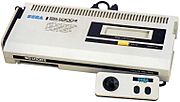 |
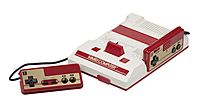 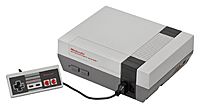  |
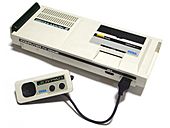 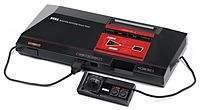 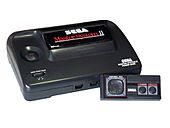 |
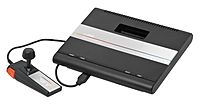 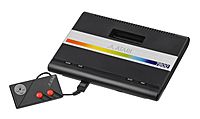 |
|
| Release Date |
|
|
|
|
|
| Game Format |
|
|
Cartridge | ||
| Top Games | N/A | Super Mario Bros. (40.24 million) | Hang-On and Safari Hunt (built-in) | Pole Position II (pack-in) | |
| Play Older Games? | No | No | Yes (SG-1000, Japan only) | Yes (Atari 2600) | |
| Main Processor | Zilog Z80-based (3.58 MHz) | MOS Technology 6502-based (1.79 MHz) | Zilog Z80A (4 MHz) | Custom MOS Technology 6502 (1.19 or 1.79 MHz) | |
| Colors on Screen | 16 | 25 | 32 | 25 | |
Other Consoles of the Era
-
Family Computer Disk System (1986)
-
VTech Socrates (1988)
-
Amstrad GX4000 (1990)
-
Commodore 64 Games System (1990)
Who Sold the Most?
The NES/Famicom sold the most units by far in this generation, especially in Japan and North America. In North America in 1989, Nintendo had a huge 94% of the market share, compared to Sega's 6%. The NES sold 1.1 million units in North America in 1986, which was much more than the Master System and Atari 7800 combined. By 1990, Nintendo had 93% of the North American market. This was thanks to Nintendo's great games like Super Mario Bros., Metroid, and The Legend of Zelda. Also, Nintendo had strict rules that made game developers keep their games only on the NES for two years, which limited support for other consoles.
In Europe, the competition was much tougher for the NES. The Master System was actually ahead until 1990. After that, sales became more even between the NES and Master System. Eventually, the NES slightly overtook the Master System in Western Europe, but the Master System remained more popular in places like the United Kingdom, Belgium, and Spain. In other parts of the world, the Master System was the most successful console in Brazil, South Korea, and Australia. The Dendy, which was an unofficial copy of the NES/Famicom, was the most popular in the former Soviet Union.
| Console | Company | Units Sold Worldwide | Japan | Americas | Other Regions |
|---|---|---|---|---|---|
| Nintendo Entertainment System (Famicom / NES) |
Nintendo | 61.91 million | 19.35 million | 34 million | 8.56 million |
| Master System (including licensed versions) |
Sega | 18.17 million | 1 million | United States: 2 million Brazil: 8 million |
Western Europe: 6.8 million South Korea: 720,000 Australia: 650,000 |
| Dendy (unofficial copy) |
Micro Genius | 6 million | N/A | N/A | Former USSR: 6 million |
| Famicom Disk System | Nintendo | 4.5 million | 4.5 million | N/A | N/A |
| Atari 7800 | Atari | 1 million | Unknown | 1 million | Unknown |
| Sega SG-1000 | Sega | 400,000 | 400,000 | N/A | Unknown |
| Super Cassette Vision | Epoch Co. | 300,000 | 300,000 | N/A | Unknown |
| Atari XEGS | Atari | 130,000 | N/A | 100,000 | France: 30,000 |
Important Games of the Era
This generation gave us many classic games that are still loved today!
- Alex Kidd in Miracle World (SMS) by Sega featured Sega's first main character, Alex Kidd.
- Castlevania (NES) by Konami started the famous Castlevania series, based on the story of Dracula.
- Dragon Quest (NES) by Chunsoft and Enix launched the popular Dragon Quest series in 1986.
- Final Fantasy (NES) by Square began the legendary Final Fantasy series in 1987.
- The Legend of Zelda (NES) by Nintendo started the amazing Legend of Zelda series in 1986.
- Mega Man 2 (NES) by Capcom was a huge hit in the Mega Man series. This series had many successful games and spin-offs.
- Metal Gear (MSX2) by Konami started the Metal Gear series in 1987. It was known for its stealth gameplay.
- Metroid (NES) by Nintendo launched the Metroid series in 1986, featuring the brave bounty hunter Samus Aran.
- Ninja Gaiden (NES) by Tecmo started the Ninja Gaiden series in 1988. It was famous for being very challenging and having early story scenes.
- Phantasy Star (SMS) by Sega was an important role-playing game. It was one of the first to have a science fiction setting and a female main character.
- Super Mario Bros. (NES) by Nintendo came bundled with the NES and became one of the best-selling video games ever. Many games tried to copy its style.
- Super Mario Bros. 3 (NES) by Nintendo is often considered one of the best side-scrolling platform games of its time. Its jumping and world map features influenced many future Mario games.
See also
 In Spanish: Videoconsolas de tercera generación para niños
In Spanish: Videoconsolas de tercera generación para niños










